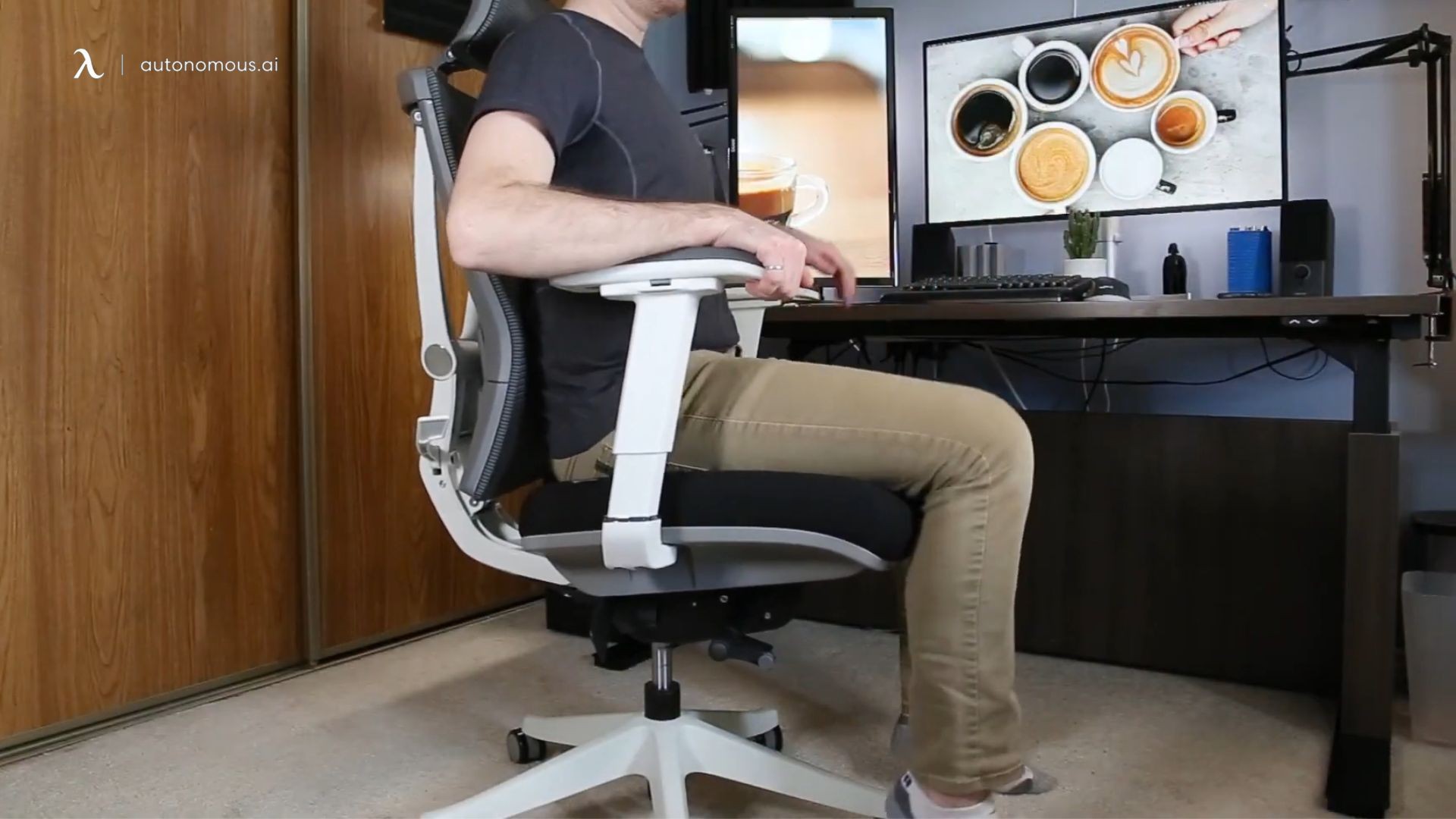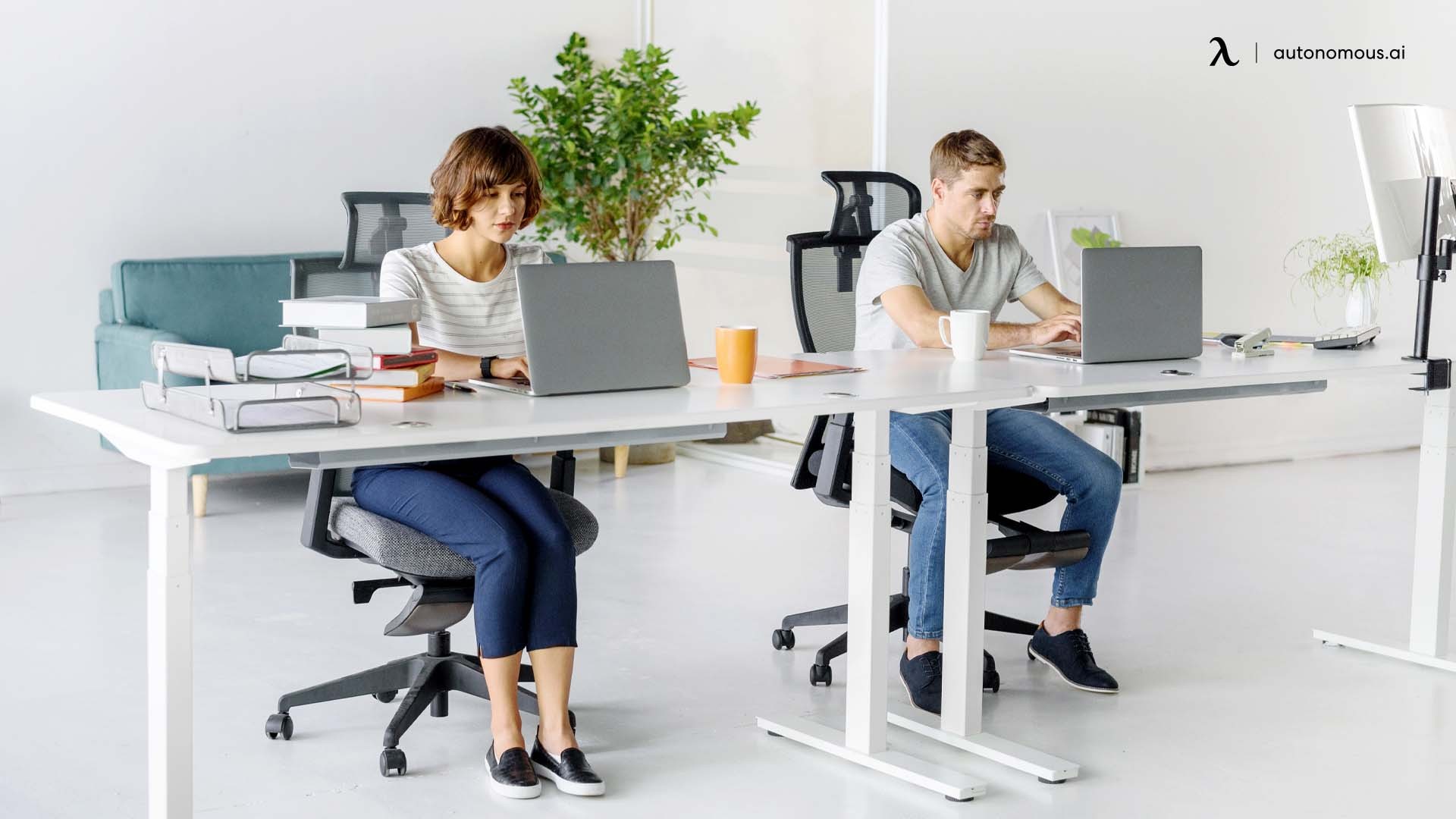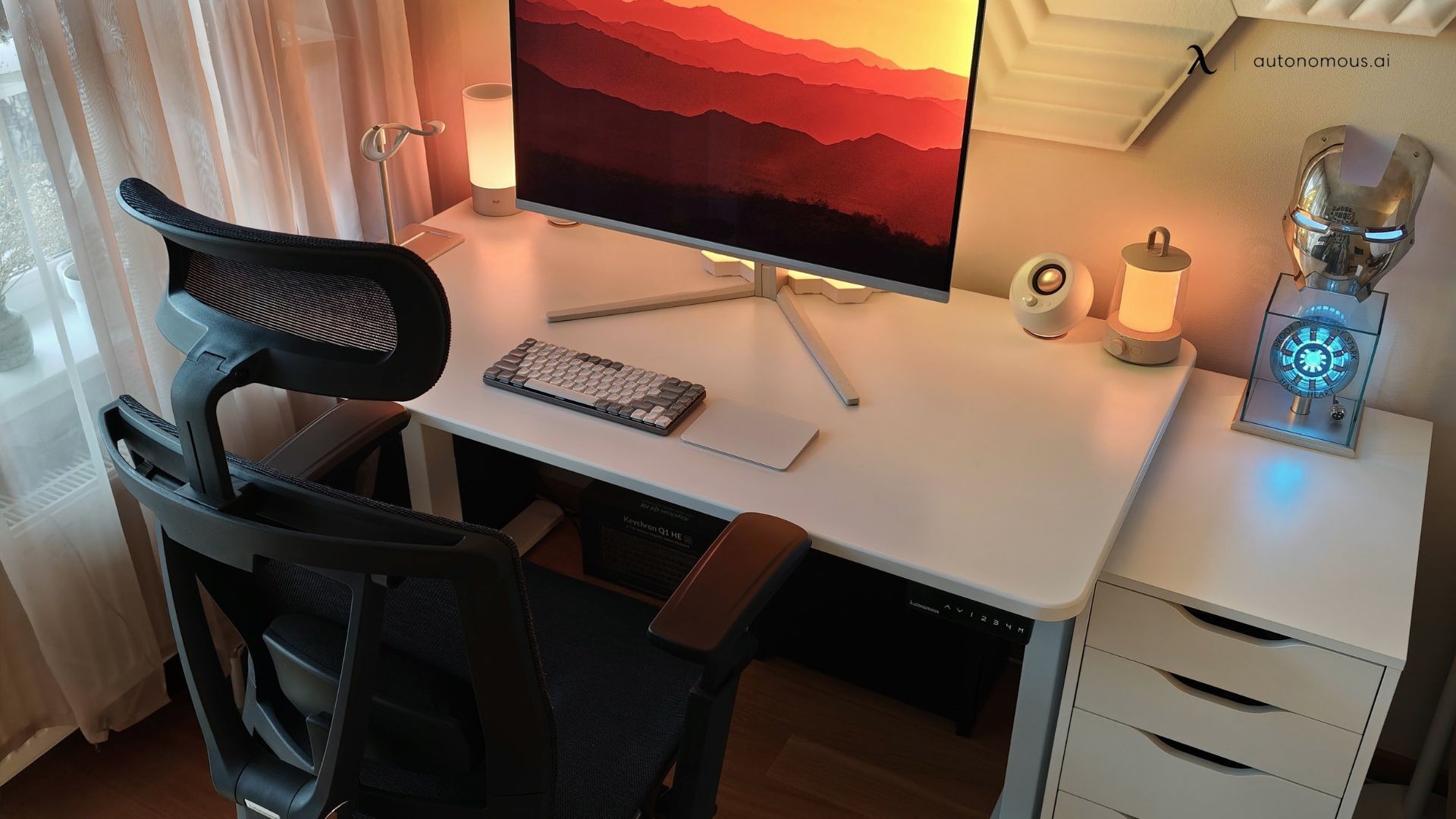How High Should My Chair Be Compared To My Desk? The correct chair height is crucial for maintaining proper posture, reducing strain, and boosting productivity, and COMPARE.EDU.VN is here to help you find that sweet spot. By adjusting your chair height, you can create an ergonomic workstation that promotes comfort and well-being, using tools like adjustable desks and monitor arms. Discover your optimal chair height and enhance your work experience, focusing on office ergonomics and posture correction.
1. Understanding the Importance of Chair Height
Choosing the correct chair height is more than just a matter of comfort; it’s an essential factor in promoting good posture, reducing physical strain, and ultimately increasing your productivity. When your chair is at the right height relative to your desk, you can maintain a neutral spine, avoid unnecessary pressure on your joints, and improve your overall well-being.
- Promotes Good Posture: Proper chair height ensures that your spine is aligned correctly, minimizing the risk of back pain and other musculoskeletal issues.
- Reduces Strain: Correct chair height prevents strain on your neck, shoulders, and wrists, allowing you to work comfortably for extended periods.
- Increases Productivity: When you’re comfortable and pain-free, you can focus better on your tasks, leading to increased efficiency and productivity.
2. Standard Chair Height Guidelines
While individual preferences vary, general guidelines for standard chair heights exist based on the user’s height and desk height. Understanding these guidelines can provide a starting point for finding your ideal chair height.
- User Height vs. Chair Height: The table below provides a range of recommended chair heights based on the user’s height, helping you select an appropriate starting point.
| User Height (Feet) | User Height (cm) | Recommended Chair Height (Inches) | Recommended Chair Height (cm) |
|---|---|---|---|
| 4’11” – 5’2″ | 150 – 158 | 14 – 16 | 36 – 41 |
| 5’3″ – 5’6″ | 159 – 167 | 16 – 18 | 41 – 46 |
| 5’7″ – 5’10” | 168 – 176 | 17 – 19 | 43 – 48 |
| 5’11” – 6’2″ | 177 – 188 | 18 – 20 | 46 – 51 |
| 6’3″ – 6’6″ | 189 – 198 | 19 – 21 | 48 – 53 |
| 6’7″ and above | 199 and above | 20 – 22 | 51 – 56 |



- Desk Height Considerations: In North America, the standard desk height is typically around 29 inches. Your chair height should be adjusted so that your elbows are at a 90-degree angle when typing, and your wrists are straight.
- Adjustable Ergonomic Chairs: These chairs are designed to be customized to individual needs, offering a wider range of height adjustments than standard chairs.
3. Finding Your Ideal Office Chair Height
While standard guidelines provide a starting point, finding the ideal office chair height requires a more personalized approach. Several factors need to be considered to ensure optimal comfort and ergonomics.
3.1. The Feet-on-the-Floor Test
The most fundamental aspect of determining correct chair height is ensuring that your feet can rest flat on the floor.
- Proper Leg Angle: When seated, your knees should be bent at a 90-degree angle. This promotes healthy circulation and prevents strain on your legs and back.
- Avoid Dangling Feet: If your feet dangle, you may need to lower your chair or use a footrest to achieve the correct leg angle.
- Avoid Over-Lowering: Lowering the chair too far can put excessive pressure on your sit bones, causing discomfort and potential health issues.
3.2. Arm and Desk Alignment
The position of your arms relative to your desk is another crucial factor in finding the ideal chair height.
- Forearms Parallel to Desk: Your forearms should be parallel to your desk, with your elbows bent at a 90 to 110-degree angle.
- Shoulder Relaxation: Correct arm and desk alignment prevents you from hunching your shoulders, reducing strain on your neck and upper back.
- Keyboard Tray Considerations: Using a keyboard tray can help bring your keyboard to the correct height, further improving your arm and wrist posture.
3.3. Seat Inclination and Support
The angle of your seat and the level of back support provided by your chair can also affect your overall comfort and posture.
- Slight Forward Tilt: A slight forward tilt in your seat can help maintain the natural curve of your spine and reduce pressure on your spinal discs.
- Lumbar Support: Ensure that your chair provides adequate lumbar support to prevent slouching and maintain a healthy lower back posture.
- Seat Wedge: If your chair lacks a forward tilt feature, consider using a seat wedge to achieve the desired angle.
3.4. Eye Level and Monitor Placement
The height and position of your monitor should also be considered when determining your ideal chair height.
- Eyes Level with Screen: When seated, your eyes should be level with the top of your monitor screen. This prevents you from straining your neck by looking up or down excessively.
- Monitor Arm: A monitor arm allows you to easily adjust the height and position of your monitor, further optimizing your workstation ergonomics.
- Proper Viewing Distance: Maintain a comfortable viewing distance from your monitor to prevent eye strain and fatigue.
4. Tools and Accessories to Achieve the Ideal Chair Height
Several tools and accessories can help you achieve the ideal chair height and create an ergonomic workstation.
4.1. Height-Adjustable Desks
Height-adjustable desks allow you to customize the height of your work surface, making it easier to align your chair, arms, and monitor correctly.
- Standing and Sitting Options: Height-adjustable desks enable you to alternate between sitting and standing throughout the day, promoting better circulation and reducing sedentary behavior.
- Customizable Workstation: These desks allow you to create a truly personalized workstation that meets your specific needs and preferences.
- Improved Posture: By adjusting the desk height to match your chair and body, you can maintain a neutral spine and reduce the risk of musculoskeletal issues.
4.2. Ergonomic Chairs
Ergonomic chairs are designed to provide optimal support and comfort, with adjustable features that allow you to customize the chair to your body.
- Adjustable Lumbar Support: Ergonomic chairs often feature adjustable lumbar support, which helps maintain the natural curve of your spine and prevent back pain.
- Adjustable Seat Depth: Seat depth adjustment allows you to customize the distance between the seat and the backrest, ensuring proper support for your thighs.
- Adjustable Armrests: Adjustable armrests can be positioned to support your arms and shoulders, reducing strain on your upper body.
4.3. Keyboard Trays
Keyboard trays bring your keyboard to the correct height, improving your arm and wrist posture and reducing strain.
- Adjustable Height and Angle: Keyboard trays often feature adjustable height and angle, allowing you to customize the position of your keyboard to your specific needs.
- Wrist Support: Many keyboard trays also include wrist support, which helps prevent carpal tunnel syndrome and other repetitive strain injuries.
- Improved Comfort: By positioning your keyboard correctly, you can improve your comfort and reduce fatigue, leading to increased productivity.
4.4. Monitor Arms
Monitor arms allow you to easily adjust the height, distance, and angle of your monitor, optimizing your viewing experience and reducing neck and eye strain.
- Increased Flexibility: Monitor arms provide a wide range of adjustments, allowing you to position your monitor exactly where you need it.
- Space Saving: By lifting your monitor off your desk, monitor arms can free up valuable workspace.
- Improved Posture: Correct monitor placement promotes good posture, reducing the risk of neck and back pain.
4.5. Footrests
Footrests provide support for your feet, ensuring that your legs are at the correct angle and preventing strain on your lower back.
- Improved Circulation: Footrests promote healthy circulation in your legs and feet, reducing the risk of swelling and discomfort.
- Reduced Back Strain: By supporting your feet, footrests can help reduce strain on your lower back and improve your overall posture.
- Adjustable Height and Angle: Many footrests feature adjustable height and angle, allowing you to customize the support to your specific needs.
5. Common Mistakes to Avoid When Adjusting Your Office Chair Height
Adjusting your office chair height correctly is crucial for maintaining good posture and preventing discomfort. However, many people make common mistakes that can negate the benefits of proper ergonomics.
5.1. Neglecting Arm Position
- Problem: Incorrect arm position can lead to shoulder and neck strain.
- Solution: Ensure your forearms are parallel to the desk and elbows are at a 90-degree angle. Use adjustable armrests if necessary.
5.2. Ignoring Foot Placement
- Problem: Dangling or unsupported feet can cause pressure on thighs and lower back.
- Solution: Ensure your feet are flat on the floor. Use a footrest if your chair is too high.
5.3. Overlooking Back Support
- Problem: Lack of lumbar support can lead to slouching and back pain.
- Solution: Adjust your chair to fully utilize its lumbar support, maintaining the natural curve of your spine.
5.4. Setting Chair Height Based on Desk Height Alone
- Problem: Adjusting solely based on desk height can compromise overall posture.
- Solution: Prioritize your body’s needs first—feet flat on the floor, arms at a comfortable angle—then adjust desk or use accessories if needed.
5.5. Not Considering Personal Body Dimensions
- Problem: Assuming one chair height fits all disregards individual differences.
- Solution: Consider your height, leg length, and torso length. Choose chairs designed for tall or short individuals if standard chairs don’t fit.
6. Case Studies and Research
Numerous studies have highlighted the importance of proper chair height and workstation ergonomics.
- University of California, Berkeley Study: Research showed that employees with adjustable workstations, including chairs and desks, reported significantly less musculoskeletal discomfort.
- Cornell University Ergonomics Lab: Studies emphasized the importance of proper lumbar support and arm positioning in reducing back and neck pain.
- NIOSH (National Institute for Occupational Safety and Health): Guidelines recommend regular breaks and adjustments to workstation setup to prevent repetitive strain injuries.
7. Expert Opinions and Recommendations
Ergonomic experts and healthcare professionals emphasize the importance of proper chair height for overall well-being.
- Dr. Alan Hedge, Cornell University: Recommends adjusting chair height so that thighs are parallel to the floor and feet are flat, reducing pressure on the lower back.
- Karen Jacobs, Boston University: Stresses the need for adjustable armrests to support the weight of the arms and prevent shoulder strain.
- OSHA (Occupational Safety and Health Administration): Provides guidelines on workstation ergonomics, including proper chair height, to prevent workplace injuries.
8. FAQ: Frequently Asked Questions about Chair Height
Q1: What is the ideal chair height for a 5’10” person?
A1: For someone who is 5’10”, a chair height between 17 and 19 inches is generally recommended, but it’s essential to adjust based on individual comfort and desk height.
Q2: How do I know if my chair is too high?
A2: If your feet are dangling or you can’t comfortably rest them on the floor, your chair is likely too high. You may also feel pressure on the back of your thighs.
Q3: What are the benefits of using a footrest?
A3: A footrest can help maintain proper posture, reduce strain on your lower back, and improve circulation by ensuring your feet are supported.
Q4: Can an adjustable desk improve my chair height?
A4: Yes, an adjustable desk allows you to match your desk height to your chair height, creating an ergonomic workstation that promotes comfort and well-being.
Q5: How important is lumbar support in a chair?
A5: Lumbar support is crucial for maintaining the natural curve of your spine and preventing back pain. Look for chairs with adjustable lumbar support.
Q6: What should I do if my chair won’t go high enough?
A6: Consider using an office chair height extender or purchasing a new chair with a wider range of height adjustments.
Q7: How can I prevent slouching in my office chair?
A7: Ensure your chair provides adequate lumbar support, adjust your seat inclination, and take regular breaks to stretch and reposition yourself.
Q8: Is it better to have armrests or no armrests on an office chair?
A8: Adjustable armrests are generally recommended, as they can support the weight of your arms and prevent shoulder strain.
Q9: How do I adjust my monitor height for optimal ergonomics?
A9: Your eyes should be level with the top of your monitor screen. Use a monitor arm or stand to adjust the height as needed.
Q10: What are some signs that my workstation is not ergonomically sound?
A10: Signs include frequent back or neck pain, eye strain, wrist pain, and general discomfort while working.
9. Conclusion: Optimizing Your Workstation for Comfort and Productivity
Finding the ideal chair height is a crucial step in creating an ergonomic workstation that promotes comfort, reduces strain, and boosts productivity. By following the guidelines and tips outlined in this article, you can customize your chair and desk setup to meet your specific needs and preferences. Remember to consider your individual body dimensions, desk height, and the tools and accessories available to achieve optimal ergonomics.
Don’t let discomfort and poor posture hinder your work performance. Visit COMPARE.EDU.VN today to explore comprehensive comparisons of ergonomic chairs, adjustable desks, and other workstation accessories. Make an informed decision and invest in your well-being by creating a workspace that supports your health and enhances your productivity. At COMPARE.EDU.VN, we provide the detailed information you need to make smart choices for a better work life.
Our mission at COMPARE.EDU.VN is to help you compare products, services and ideas so you can make the best choice.
Visit us at 333 Comparison Plaza, Choice City, CA 90210, United States or contact us via Whatsapp at +1 (626) 555-9090. We’re here to help you make informed decisions! Visit our website: compare.edu.vn.
